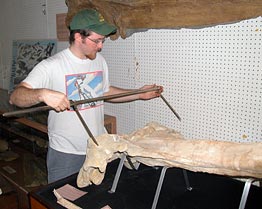|
abundances? How did all these animals die? How was the bonebed formed? “The whole depositional setting of this part of the Round Mountain Silt is still not well understood, especially with the bonebed,” says Randall. To try and answer these and other questions, Nick and Randall plan to return to Sharktooth Hill this summer with a larger crew to conduct a more comprehensive study of the bonebed taphonomy, and, of course, to look for more fossils. “None of this would be possible without Bob Ernst and the amateur paleontology community at Bakersfield,” Nick says. Landowners and amateurs play a vital role in the preservation of any fossil localities, and their participation is key in helping gather the fossils needed for Nick and Randall’s research. And, Nick adds, “If taking part in conserving such a resource can inspire people to care more about the world around them, so much the better!”

Nick Pyenson measuring a fossil sperm whale skull (Aulophyseter morricei) in the collections at the Buena Vista Museum of Natural History, Bakersfield, CA. (photo by Randall Irmis)
|
|
 The skull of Allodesmus sp., a fossil sea lion that was recovered at Sharktooth Hill. (photo by Nick Pyenson)
The skull of Allodesmus sp., a fossil sea lion that was recovered at Sharktooth Hill. (photo by Nick Pyenson)
 We look forward to hearing more Sharktooth Hill news from Nick and Randall this fall. We look forward to hearing more Sharktooth Hill news from Nick and Randall this fall.
1 Lynch, S.C., and J. Parham. 2003. The first report of hard-shelled sea turtles (Cheloniidae sensu lato) from the Miocene of California, including a new species (Euclastes hutchisoni) with unusually plesiomorphic characters. PaleoBios 23(3):21–35.
2 Stidham, T.A. 2004. New skull material of Osteodontornis orri (Aves: Pelagornithidae) from the Miocene of California. PaleoBios 24(2):7–12.)
|
A final note of appreciation to Pat Holroyd for her input on this article.
|

 May, 2005 May, 2005
|